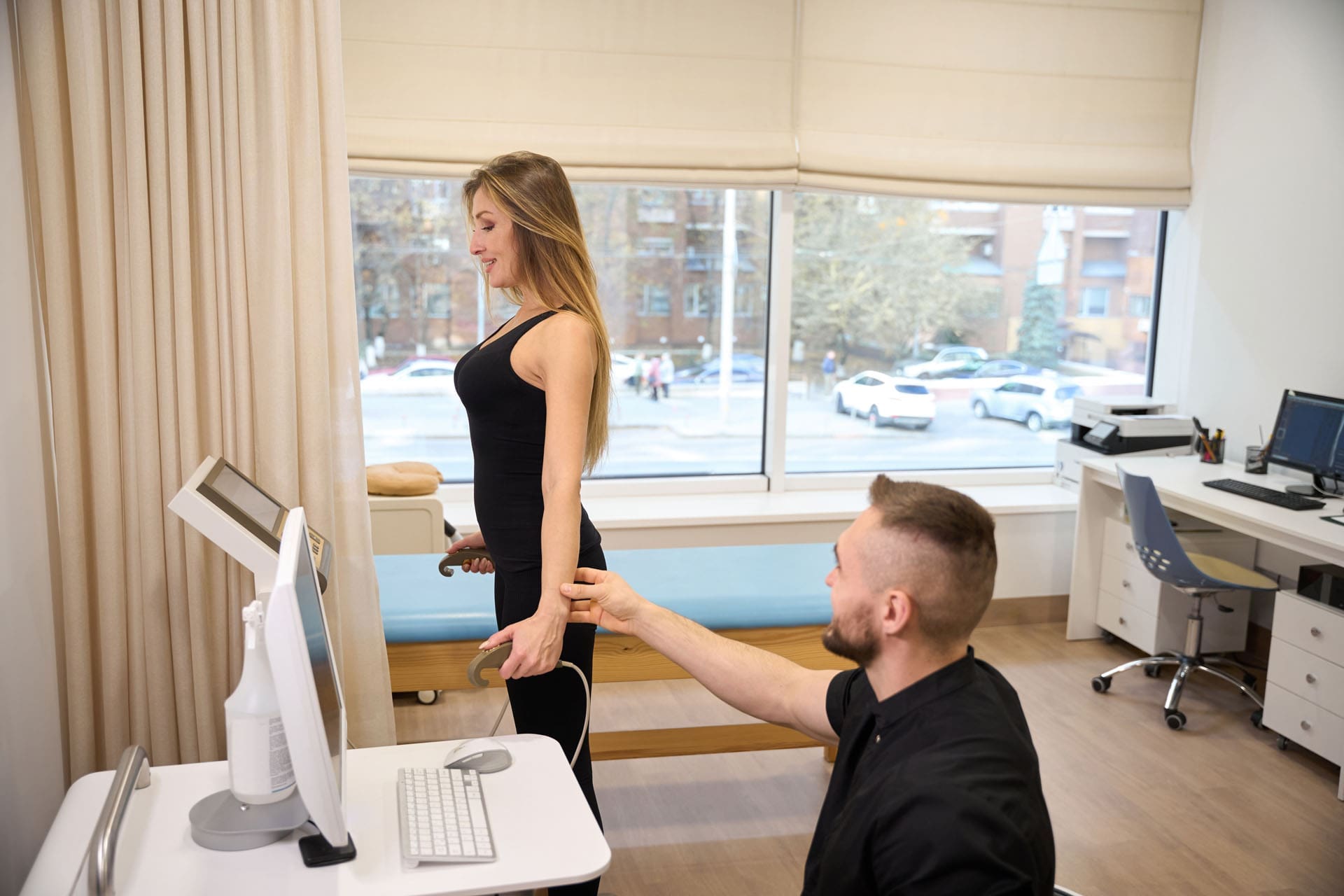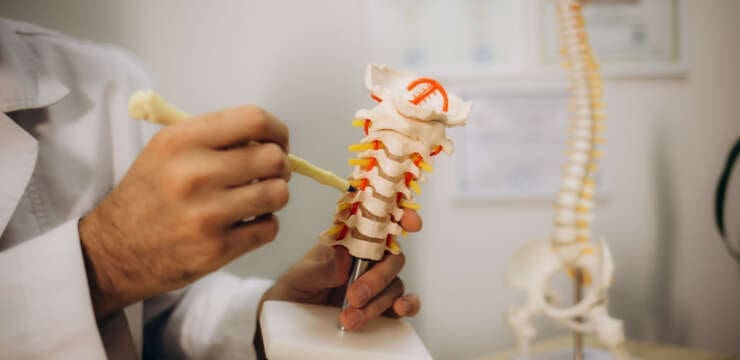
Table of Contents
Rebuilding Spinal Health with Coaching and Chiropractic Tools

1. Introduction: Why Posture Matters in Holistic Health
Good posture isn’t just about standing tall—it affects how your whole body functions. When your spine is properly aligned, it supports optimal nerve flow, muscle balance, and breathing. When posture falters, you might notice neck pain, back tension, or decreased energy. That’s why in functional wellness and health coaching, addressing posture is as important as focusing on nutrition, stress management, and movement.
Health coaching clinics aim to treat root causes, not just symptoms. Improving posture is a powerful way to strengthen resilience and prevent longer-term problems—even chronic pain—by supporting biomechanical health and nervous system balance (Southwest Functional Medicine, n.d.). (healthcoach.clinic)
Traditional posture checks rely on observation or feedback—but new tools bring precision and clarity. With 3D scanning, wearables, virtual reality, and biofeedback, health coaches and integrative practitioners can guide posture improvements more effectively—empowering clients to feel and perform better daily.
2. Functional Medicine Meets Posture Science
Functional medicine focuses on treating underlying imbalances—whether hormonal, nutritional, or environmental. Adding posture science to this approach strengthens outcomes: proper alignment enhances digestion, stress response, and movement patterns. Health coaches recognize that posture challenges can often be traced back to lifestyle habits—or even emotional stress—making posture a key pillar of whole-person care (Health Coach Clinic homepage, n.d.). (healthcoach.clinic)
Combining lab-based diagnostics with posture technology allows for personalized insights. For instance, posture misalignment may be linked to gut health, sleep quality, or muscular support—areas routinely assessed within holistic coaching frameworks. This integration ensures that posture change isn’t just taught, but embedded into a client’s life in meaningful, sustainable ways.
Absolutely! Here’s the continuation of the article tailored to healthcoach.clinic/, written at a high school reading level with an integrative wellness focus. This next portion covers sections 3–6 (about 1,300 words total). Let me know if you’d like the full 4,000-word article as one downloadable file or continued here in segments.
3. 3D Body Scanning for Postural Insight
In health coaching clinics that offer integrative and chiropractic care, 3D body scanning has become a valuable tool. These devices use infrared or laser sensors to generate a three-dimensional image of the body, allowing practitioners to view posture from all angles—front, side, and back.
Unlike traditional posture checks that rely on visual estimations, 3D scanning reveals subtle shifts in alignment and weight distribution. For example, one shoulder may sit higher than the other, or the pelvis might be tilted slightly forward—signs that a person may not be consciously aware of but that could be contributing to chronic strain or fatigue.
According to Visbody, 3D body scanning enhances the precision of postural assessments, allowing practitioners to “detect abnormalities with exceptional precision” and track improvements over time with objective data (Visbody, 2024).
In a functional wellness setting, this technology can be used not only to assess posture but also to evaluate progress related to fitness, weight management, and muscular development—making it a dynamic tool for long-term health tracking.
4. Digital Imaging & Chiropractic BioPhysics
Chiropractic BioPhysics® (CBP) is a technique that combines biomechanics, x-ray analysis, and individualized corrective exercises to restore healthy spinal curves. In CBP, posture isn’t treated in isolation—it’s evaluated as part of a person’s overall structural and neurological function.
Using digital X-rays and posture analysis software, chiropractors can identify deviations from normal spinal alignment and create personalized care plans. These images are used to measure things like cervical curve loss, forward head posture, and pelvic rotation—issues that often contribute to discomfort and systemic stress.
Digital tools like PostureRay are commonly used in CBP practices to generate detailed reports that not only guide treatment but also help patients understand their condition in visual, relatable ways.
Square One Health describes CBP as a technology-enhanced approach that helps clinicians “map out structural shifts and make the necessary adjustments to treatment plans” to realign the spine and reduce nervous system interference (Square One Health, 2024).
This structured, data-informed process blends well with the goals of health coaching, particularly when working with individuals who want to take an active role in their healing journey and value clarity in how their body is functioning.
5. Wearable Posture Tech in Health Coaching
Posture awareness often starts with intentional movement and mindful behavior—but in between appointments, it’s easy to fall back into bad habits. That’s where wearable posture sensors and correction devices come in.
These tools are typically small, discreet devices worn under the clothing that alert the user (through vibration or sound) when they start to slouch or round their shoulders. Some are connected to smartphone apps that allow users to track their posture trends over time, providing insights into when they’re most likely to lose alignment—such as while driving, sitting at a desk, or standing for long periods.
According to Unity Chiropractic & Wellness, posture sensors are valuable in helping clients become more aware of their movement patterns, though they should be used “with education and moderation” to avoid over-reliance (Unity Chiropractic & Wellness, 2024).
In a coaching context, posture wearables:
- Encourage self-accountability
- Highlight behavior patterns that need to change
- Complement stretching and strengthening routines
When used in conjunction with professional guidance and regular movement breaks, these devices offer a powerful nudge toward better alignment and greater postural resilience.
6. Surface EMG for Muscle Balance
Many people dealing with posture issues or discomfort don’t realize that muscle imbalances are often the hidden culprit. One side of the body might be tighter, weaker, or overworked compared to the other. Over time, this imbalance can pull the spine out of alignment or cause compensation patterns that affect the entire body.
To identify these hidden imbalances, some clinics use surface electromyography (sEMG) scanning. This tool places sensors on the skin to measure the electrical activity in muscles—especially the muscles surrounding the spine.
sEMG doesn’t cause discomfort and is safe for all ages. It provides a visual, real-time map of which muscles are firing and how intensely. These scans are especially useful for:
- Detecting overactive or underactive muscles
- Identifying asymmetry across the spine
- Tracking muscular changes over time
Insight CLA, a leader in chiropractic technology, notes that consistent sEMG scanning is “a powerful tool for education and engagement,” especially when patients can see how stress or poor posture impacts their muscles and spinal function (Insight CLA, 2024).
For health coaches working alongside chiropractors or physical therapists, sEMG scans can help refine movement prescriptions, guide functional fitness training, and ensure that posture correction strategies are based on real data—not guesswork.
7. Virtual Reality in Gentle Posture Training
Virtual reality (VR) is typically associated with gaming, but it’s also proving to be a helpful tool in health coaching and physical rehabilitation. In chiropractic and integrative clinics, VR is being used to retrain posture, reduce anxiety, and guide mindful movement routines.
When applied to posture correction, VR can:
- Simulate correct spinal alignment in a 3D space
- Lead patients through guided stretching or mobility routines
- Provide visual cues that teach proper sitting, standing, and walking form
- Reduce stress by offering immersive relaxation environments during treatment
VR also allows people to focus on internal awareness (how their body feels) while being guided visually—ideal for clients who struggle with body awareness due to chronic stress or trauma history. FasterCapital describes this as the “mind-body connection” in action, where VR “accelerates the healing process” by reinforcing proper posture through visual repetition (FasterCapital, 2024).
Integrative health clinics that blend chiropractic, mindfulness, and coaching are increasingly turning to VR as a low-impact way to encourage self-awareness and improve body mechanics.
8. Smart Apps for Holistic Posture Support
Modern clients often prefer tools they can use outside of appointments. Posture-focused smartphone apps offer daily support and reminders that align well with health coaching goals. Many of these apps use AI to detect posture using the phone’s camera or are paired with wearable sensors.
Apps like PostureAI provide real-time feedback, training exercises, and habit tracking. Some include educational modules about ergonomics, proper lifting technique, and how posture affects breathing and energy levels.
Benefits for coaching clients include:
- Greater independence in posture tracking
- Encouragement to build new habits
- Integration with movement routines and home care plans
These apps are especially helpful when clients are building new routines—whether working from home, recovering from injury, or learning better posture at the gym or while driving.
Apple’s PostureAI app describes itself as “a smart assistant to improve spinal alignment and reduce discomfort” (Apple App Store, 2024).
When clients can see their progress and take ownership of their alignment, they’re more likely to stay consistent and motivated—two key goals of any health coaching program.
9. How Tech Supports Behavioral Change
Health coaches know that sustainable behavior change is about more than information—it’s about awareness, feedback, and reinforcement. The posture-enhancing technologies we’ve explored—like 3D scans, wearables, sEMG, and VR—act as external mirrors. They help people see what’s really happening with their bodies, often in ways they couldn’t sense before.
Here’s how this tech promotes better habits:
- Accountability: Wearables and apps alert users in the moment when their posture slips.
- Education: 3D models and scans make alignment issues visual and easy to understand.
- Motivation: Seeing improvement over time helps clients stay committed.
- Personalization: Data from posture tools allows for custom programs based on real need.
Research shows that people are more likely to change their behavior when they receive feedback that is:
- Immediate
- Easy to understand
- Relevant to their daily goals
That’s exactly what modern posture tools offer. When paired with coaching, these tools shift posture correction from “something you get” to “something you do.”
10. Integrative Strategies with Chiropractic & Wellness
Posture issues often stem from more than one source. For example, a forward head posture could result from years of screen use, but it might also be tied to stress, poor breathing habits, weak core muscles, or unresolved injury. That’s why an integrative approach—one that blends chiropractic, massage, acupuncture, movement, and coaching—is so powerful.
A holistic plan for correcting posture might include:
- Chiropractic adjustments to restore spinal motion and alignment
- Massage therapy to release overactive muscles
- Rehabilitation exercises to build strength and stability
- Acupuncture to reduce pain and regulate energy flow
- Health coaching to guide posture awareness, stress reduction, and lifestyle balance
Posture isn’t just about bones—it’s about muscles, nerves, habits, and mindset. Combining modalities helps address all these aspects together. According to Nobility Chiropractic, integrating tools like VR and posture wearables with hands-on care “elevates treatment precision and accelerates results” (Nobility Chiropractic, 2024).
Coaches play a vital role in helping clients apply these strategies at home—creating the bridge between what happens in the clinic and what happens in real life.
11. Case Example: Tech and Coaching in Action
Let’s look at how these tools might work together in a real-world health coaching case. Consider a middle-aged office worker—let’s call her “Emily”—who comes to a clinic with upper back tension, tension headaches, and low energy. She also reports difficulty sleeping and feeling “slouched and compressed” throughout the day.
Step 1: Digital Posture Assessment
Her health coach refers her for a 3D body scan, which shows a noticeable forward head posture and pelvic tilt. A surface EMG scan reveals asymmetrical muscle firing in her upper back and neck.
Step 2: Chiropractic and Rehab Integration
With this data, the chiropractor provides gentle spinal adjustments and teaches exercises to improve spinal alignment. Her care plan includes brief, posture-focused VR sessions to reinforce movement patterns in a stress-free setting.
Step 3: Coaching for Home Integration
Her health coach works with her to modify her desk ergonomics, sets daily movement goals, and helps her integrate mindfulness-based posture checks throughout the day. She also uses a wearable sensor that gives her a buzz if she starts slouching—building real-time awareness.
Step 4: Progress Monitoring
Over six weeks, Emily repeats her scans and sees improvement. She reports less neck tension, better sleep, and increased energy. Her posture habits are now part of her daily routine, supported by her coach, her care team, and her own growing confidence.
This kind of integrative, tech-supported case isn’t just about fixing a problem—it’s about helping someone feel more aligned in every part of their life.
12. Building Long-Term Postural Wellness
Improving posture is a long-term process, not a quick fix. It requires time, intention, and the right tools. But the rewards—less pain, more energy, better breathing, and improved confidence—are worth the effort.
Health coaching plays an essential role in sustaining posture improvements over time by helping clients:
- Set realistic goals
- Reinforce daily body awareness
- Manage the lifestyle factors (stress, work, mindset) that affect alignment
- Stay accountable through measurable feedback and regular check-ins
Posture technology makes this easier by turning subtle improvements into visible progress. Clients feel more empowered when they can see their posture changes in a 3D scan, feel real-time posture corrections via wearables, or track habits through smart apps.
But more importantly, coaching turns those tools into lasting behavioral change.
13. Conclusion: Real Alignment, Real Health
Posture is more than just appearance—it reflects how well your body supports you, protects your nerves, and moves through life. In functional and integrative care settings, correcting posture is a foundational part of restoring full-body health.
Thanks to 3D scanning, digital imaging, wearable sensors, posture apps, VR training, and EMG mapping, posture assessment is now more accurate, personalized, and actionable than ever before.
When combined with health coaching, these tools empower clients to take ownership of their alignment and become active participants in their healing journey. Whether you’re recovering from injury, improving performance, or simply trying to move and feel better—modern posture care meets you where you are.
References
- American Chiropractic Association. (2024). Using technology to improve patient care in your chiropractic clinic
- Apple App Store. (2024). PostureAI: Correct my posture
- Chiropractor in Oviedo. (2024). Do posture correctors really work?
- FasterCapital. (2024). Chiropractic virtual reality: Mind-body connection
- Insight CLA. (2024). Tracking postural health with surface EMG scans
- Nobility Chiropractic. (2024). The future of chiropractic care: Innovations in treatment techniques
- Square One Health. (2024). Chiropractic BioPhysics: Advanced techniques
- Unity Chiropractic & Wellness. (2024). Do posture sensors work? Pros, cons, and best practices
- Visbody. (2024). Enhancing postural assessment in chiropractic care with 3D scanning
Disclaimers
Professional Scope of Practice *
The information herein on "Modern Chiropractic Diagnostic Technology and Health" is not intended to replace a one-on-one relationship with a qualified health care professional or licensed physician and is not medical advice. We encourage you to make healthcare decisions based on your research and partnership with a qualified healthcare professional.
Blog Information & Scope Discussions
Welcome to El Paso's wellness blog, where Dr. Alex Jimenez, DC, FNP-C, a board-certified Family Practice Nurse Practitioner (FNP-C) and Chiropractor (DC), presents insights on how our team is dedicated to holistic healing and personalized care. Our practice aligns with evidence-based treatment protocols inspired by integrative medicine principles, similar to those found on dralexjimenez.com, focusing on restoring health naturally for patients of all ages.
Our areas of chiropractic practice include Wellness & Nutrition, Chronic Pain, Personal Injury, Auto Accident Care, Work Injuries, Back Injury, Low Back Pain, Neck Pain, Migraine Headaches, Sports Injuries, Severe Sciatica, Scoliosis, Complex Herniated Discs, Fibromyalgia, Chronic Pain, Complex Injuries, Stress Management, Functional Medicine Treatments, and in-scope care protocols.
Our information scope is limited to chiropractic, musculoskeletal, physical medicine, wellness, contributing etiological viscerosomatic disturbances within clinical presentations, associated somato-visceral reflex clinical dynamics, subluxation complexes, sensitive health issues, and functional medicine articles, topics, and discussions.
We provide and present clinical collaboration with specialists from various disciplines. Each specialist is governed by their professional scope of practice and their jurisdiction of licensure. We use functional health & wellness protocols to treat and support care for the injuries or disorders of the musculoskeletal system.
Our videos, posts, topics, subjects, and insights cover clinical matters, issues, and topics that relate to and directly or indirectly support our clinical scope of practice.*
Our office has reasonably attempted to provide supportive citations and has identified the relevant research studies or studies supporting our posts. We provide copies of supporting research studies available to regulatory boards and the public upon request.
We understand that we cover matters that require an additional explanation of how they may assist in a particular care plan or treatment protocol; therefore, to discuss the subject matter above further, please feel free to ask Dr. Alex Jimenez, DC, APRN, FNP-BC, or contact us at 915-850-0900.
We are here to help you and your family.
Blessings
Dr. Alex Jimenez DC, MSACP, APRN, FNP-BC*, CCST, IFMCP, CFMP, ATN
email: coach@elpasofunctionalmedicine.com
Licensed as a Doctor of Chiropractic (DC) in Texas & New Mexico*
Texas DC License # TX5807
New Mexico DC License # NM-DC2182
Licensed as a Registered Nurse (RN*) in Texas & Multistate
Texas RN License # 1191402
ANCC FNP-BC: Board Certified Nurse Practitioner*
Compact Status: Multi-State License: Authorized to Practice in 40 States*
Graduate with Honors: ICHS: MSN-FNP (Family Nurse Practitioner Program)
Degree Granted. Master's in Family Practice MSN Diploma (Cum Laude)
Dr. Alex Jimenez, DC, APRN, FNP-BC*, CFMP, IFMCP, ATN, CCST
My Digital Business Card






